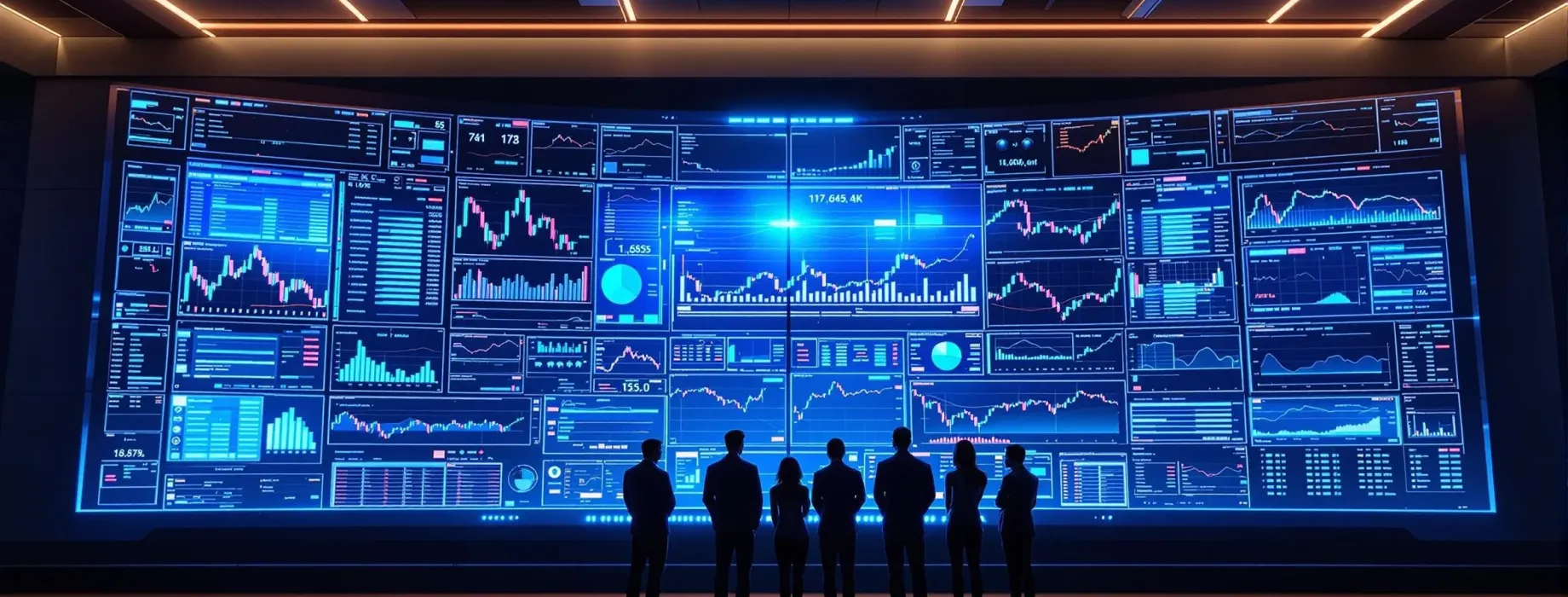- anticipate a sharp pullback,
- capitalize on fear-driven momentum, or
- protect your portfolio from tail risk,
VIX Trading: Volatility Index Strategies for Market Fear

Every trader knows that price tells a story — but volatility tells the mood. That’s where the VIX, also known as the Volatility Index or Fear Index, becomes a powerful tool in the trader’s arsenal.Rather than tracking price itself, the VIX measures how nervous the market is about the future — based on real-time expectations derived from S&P 500 options. It’s the market’s anxiety level, quantified.
When the VIX spikes, institutions are rushing for protection. When it fades, it often signals risk-on sentiment creeping back in. But more importantly: VIX movements often precede major reversals, making it a key indicator for both hedging and directional trading.
Whether you’re aiming to:
learning how to read and trade the VIX can offer a serious tactical edge in volatile markets.
In this guide, we’ll go beyond definitions. You’ll discover how the VIX behaves, what drives its moves, and how to craft actionable volatility strategies — all from the perspective of real-world traders, not textbook theorists.
📊 How the VIX Works: Behind the Volatility Curtain
To use the VIX effectively, you need more than just a headline-level understanding. The VIX doesn’t track past volatility — it anticipates future movement. Specifically, it reflects the market’s expectation of 30-day forward volatility on the S&P 500, derived from real-time options pricing.
But here’s where it gets interesting:
- The VIX rises not just when prices fall, but when traders expect large swings — up or down.
- It’s calculated using implied volatility from a broad range of near-term S&P 500 options, across multiple strike prices.
- It’s not directional — it doesn’t care if you’re bullish or bearish. It cares if the market is bracing for a move.
🔄 Typical VIX Behavior
| Market Condition | VIX Reaction |
|---|---|
| Steady bull market | VIX tends to fall below 15 |
| Rising uncertainty | VIX climbs toward 20–25 |
| Panic / market crash | VIX explodes above 30–40 |
| Policy-driven spikes | VIX may react before the S&P even moves |
🔁 Mean-Reverting Nature
Unlike stock prices, the VIX exhibits mean-reverting behavior. Extended periods of calm usually precede volatility spikes — and vice versa. This pattern makes it ideal for tactical entries, particularly when trading VIX-related instruments like VXX or futures.
📈 Volatility Is Not Risk — It’s Opportunity
High VIX doesn’t mean avoid the market. In fact, for informed traders, elevated volatility means wider ranges, faster moves, and greater potential. The key is knowing when the VIX is elevated for a reason — and when it’s overblown fear.
In the next block, we’ll explore how the VIX reflects fear and greed cycles — and how to turn those emotional extremes into trading signals.
😱 Fear and Greed Cycles in VIX: Reading the Emotional DNA of the Market
The VIX is more than a technical tool — it’s a window into crowd psychology. When traders talk about “fear in the market,” they’re often referring to what the VIX is silently screaming.
But fear and greed don’t just happen randomly. They follow repeatable behavioral cycles, often visible in VIX patterns before they manifest in price.
🔁 Anatomy of a Fear Cycle
- Complacency Phase
a. VIX trades below 15.
b. Markets grind higher, volatility sellers dominate. - Warning Signs Emerge
a. Macro stress, weak earnings, or policy uncertainty appear.
b. VIX begins to lift — often unnoticed. - Panic Spike
a. VIX surges above 25–30.
b. Risk assets plunge as traders rush for protection. - Relief and Normalization
a. VIX reverses sharply.
b. Market rebounds begin, but volatility stays elevated. - Greed Returns
a. VIX drifts lower again.
b. Traders start selling volatility, believing “the worst is over.”
📌 Historical Fear Peaks
| Event | VIX Peak |
|---|---|
| COVID-19 crash (2020) | 82.69 |
| Financial crisis (2008) | 89.53 |
| Brexit (2016) | ~26.7 |
| Flash Crash (2010) | ~48 |
In all cases, VIX peaked before the market bottomed, offering early reversal clues.
🎯 Using Cycles in Strategy
- Buy when others panic: Watch for overextensions in VIX to time contrarian trades.
- Sell into complacency: When VIX stays unnaturally low, prepare for mean reversion.
- Pair with sentiment tools: Combine VIX with put/call ratios, AAII surveys, or volatility skew to confirm crowd psychology shifts.
When you understand how fear moves in waves — not in straight lines — the VIX becomes your psychological compass, not just a volatility meter.
🔁 Volatility Trading Strategies: Turning Fear Into Opportunity
The VIX doesn’t just warn of turbulence — it also creates tradable setups for those who understand how to position around fear cycles.
Here are three efficient ways to integrate VIX dynamics into your trading playbook:
- Anticipating Volatility Before It Hits
- In periods of calm before major events (FOMC, CPI, earnings), volatility is often underpriced.
- Strategic move: take long exposure in volatility products (e.g., VIX calls, VXX) before the expected uncertainty hits.
- Key: enter early, exit quickly after the event passes or implied volatility peaks.
- Countering Volatility Spikes
- When VIX surges beyond 30, it often reflects peak fear — and markets start to stabilize.
- Tactical idea: fade extreme fear using inverse products or short-biased volatility ETFs.
- Rule: only execute with a tight stop-loss and strong risk control. Volatility can overshoot.
- Using VIX as a Timing Filter
- Low VIX (<15): signals complacency — often precedes sharp corrections.
- High VIX (>25): signals fear — useful for waiting until markets start bottoming.
- Think of VIX as a sentiment oscillator — not a trend indicator.
Volatility trading requires discipline. It’s not about chasing panic — it’s about recognizing where the fear is priced wrong, and acting with precision.
🛡 Hedging with VIX Derivatives: Smart Defense in Volatile Markets
One of the most practical uses of the VIX is portfolio protection. During market stress, VIX-linked instruments often spike — giving traders a tool to offset equity losses.
🔧 Key Hedging Instruments
- VIX Futures: Used by institutions; offer pure exposure to implied volatility.
- VXX / UVXY ETFs: Retail-friendly volatility trackers (note: UVXY is leveraged).
- VIX Options: More advanced; useful for defined-risk hedges.
🛡 Simple Hedging Idea
Own a tech-heavy portfolio? If VIX starts rising rapidly while indexes hold steady — that’s a red flag. You could:
- Buy a small VIX call spread
- Hold VXX short-term
- Trim your most volatile positions
⚠️ Caution: VIX Decay and Misuse
- Many VIX products lose value over time (contango effect)
- Don’t hold UVXY/VXX long-term unless tactically managed
- Hedging is not about profits — it’s about damage control
A well-placed volatility hedge can turn a crash into a scratch. But used improperly, VIX derivatives can do more harm than good — treat them as insurance, not a magic fix.
⚠️ Common Mistakes & Risks in VIX Trading
Trading the VIX can be profitable — but only if you avoid these costly pitfalls:
- Holding VIX Products Too Long
- Instruments like VXX and UVXY decay over time due to futures roll costs.
- Use them for short-term trades, not passive hedging.
- Shorting VIX Without a Plan
- Volatility can spike fast.
- Selling volatility naked (like shorting UVXY) without stop-losses is dangerous.
- Many blowups happen here.
- Misreading Low VIX as Safe Market
- VIX below 15 doesn’t always mean “all is well.”
- Often, it’s a sign of complacency — a setup for sharp reversals.
- Ignoring Macro Events
- VIX reacts strongly to surprise news.
- If you’re unhedged during events (FOMC, geopolitical risk), you’re exposed.
VIX trading isn’t about guessing market direction — it’s about reading emotional extremes and using them to your advantage without letting emotion control you.
🧾 Conclusion: Trade the Fear, Not the Hype
The VIX isn’t just a chart — it’s a window into the market’s collective emotion. Learning how to interpret its movements can help you:
- Avoid bad entries during high-risk periods
- Hedge your portfolio when others panic
- Spot early reversal signals based on crowd fear
But like any tool, the VIX requires context. It shines brightest when combined with macro awareness, discipline, and clear setups.
Don’t chase the spike. Don’t ignore the silence.
Use the VIX as a signal — not as a standalone strategy.
Start small. Backtest your timing. Treat volatility as fuel — not fire.
Ready to add the fear index to your trading edge?
📚 Sources
- CBOE – VIX Index Overview
Official source for VIX methodology and historical data.
→ www.cboe.com/tradable_products/vix - Bloomberg Markets – Volatility Insights
Real-time volatility charts, market sentiment coverage.
→ www.bloomberg.com/markets/volatility - Investopedia – How the VIX Works
Detailed explanation of the volatility index and its uses.
→ www.investopedia.com/terms/v/vix.asp - CME Group – VIX Futures and Options
Product specs and strategy guides for volatility derivatives.
→ www.cmegroup.com - BIS – Global Risk Indicators and Market Volatility Reports
Macro-level volatility studies and sentiment indicators.
→ www.bis.org - Federal Reserve – Market Volatility Research
Empirical studies on volatility and financial stress.
→ www.federalreserve.gov
FAQ
Can I trade the VIX directly?
No — the VIX is an index. You can only trade derivatives tied to it (futures, options, or ETFs like VXX/UVXY).
Is low VIX always bullish for stocks?
Not necessarily. Extremely low VIX often signals complacency, which can precede sharp corrections.
What’s the safest way to use VIX?
Use it as a market timing filter or to hedge existing equity exposure during uncertain conditions.
Is UVXY a good long-term hedge?
No — UVXY is designed for short-term volatility exposure. It decays quickly over time. Use it tactically, not passively.
